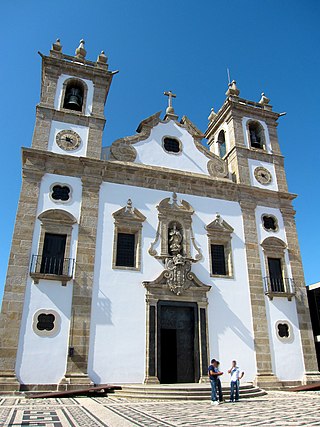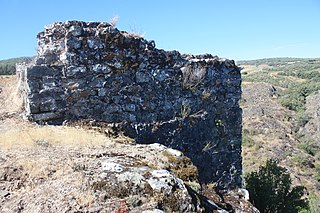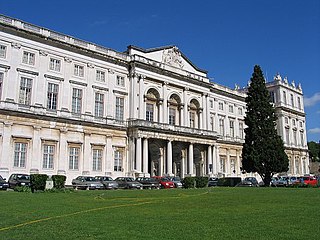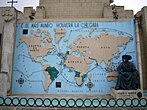
Coimbra is a city and a municipality in Portugal. The population of the municipality at the 2021 census was 140,796, in an area of 319.40 square kilometres (123.3 sq mi). The fourth-largest agglomerated urban area in Portugal after Lisbon, Porto, and Braga, it is the largest city of the district of Coimbra and the Centro Region. About 460,000 people live in the Região de Coimbra, comprising 19 municipalities and extending into an area of 4,336 square kilometres (1,674 sq mi).

Portugal is a unitary state with delegated authority to three levels of local government that cover the entire country:

Ribeira Grande is a municipality in the northern part of the island of São Miguel in the Portuguese Azores. The population in 2011 was 32,112, in an area of 180.15 km2. The municipal seat is located in the civil parish of Matriz, with a population of about 4000 inhabitants, part of the urbanized core of what is commonly referred to as the city of Ribeira Grande.
The General Confederation of the Portuguese Workers is the largest trade union federation in Portugal. It was founded informally in 1970, emerged publicly after the Carnation Revolution in 1974 and was legalised the following year by the National Salvation Junta.

Arcos de Valdevez is a municipality along the northern frontier of Portugal and Galicia (Spain). The population in 2011 was 22,847, in an area of 447.60 km2. It is the largest municipality in area of the district of Viana do Castelo.

Nelas is a municipality located in the Centro Region of continental Portugal. The population in 2011 was 14,037, in an area of 125.71 km².

Tourism in Portugal serves millions of international and domestic tourists. Tourists visit to see cities, historic landmarks, enjoy beaches, or religious sites. As of 2019, Portugal had 27 million visitors. The most popular destinations were Lisbon, Porto, the Algarve, the Portuguese Riviera, Madeira, Sintra, Óbidos and Fátima. The most popular with internationals were Lisbon, the Algarve and Northern Portugal. National tourists prefer Northern Portugal, followed by Central Portugal and the Algarve.

Santa Clara is a former civil parish in the municipality of Coimbra, Portugal. It was also known as São Francisco or São Francisco da Ponte after its foundation in 1855. The population in 2011 was 9,929, in an area of 9.77 km2. On 28 January 2013 it merged with Castelo Viegas to form Santa Clara e Castelo Viegas.
The Portuguese postal code is formed by four digits, a hyphen, then three digits, followed by a postal location of up to 25 characters in capitals.
Avenida Marconi 4C 1000-205 Lisboa

The term "provinces" has been used throughout history to identify regions of continental Portugal. Current legal subdivisions of Portugal do not coincide with the provinces, but several provinces, in their 19th- and 20th-century versions, still correspond to culturally relevant, strongly self-identifying categories. They include:

The architecture of Póvoa de Varzim, in Portugal, demonstrates a broad variety of architectural styles over its thousand years of history. 11th-century Romanesque, 16th-century Mannerism, 18th-century Baroque, late 18th-century neoclassicism, early 20th-century Portuguese modernism and late 20th- to early 21st-century contemporary architectural styles and more are all represented in Póvoa de Varzim. As a whole it represents a rich eclectic tradition and innovation shaped by the people, their beliefs and economy.

The Castro of Sacóias is a former fortified settlement and archeological site in the civil parish of Baçal, municipality of Bragança in the Alto Trás-os-Montes subregion of the Portuguese Norte Region.

The Pillory of Bragança is a 15th-century sculpted stone column with symbolic political, administrative and judicial significance, erected over a four-step octagonal platform, located in the civil parish of Sé, Santa Maria e Meixedo, municipality of Bragança. It consists of a cylindrical column erected over a square platform, sculpted with zoomorphic symbols, anthropomorphic scenes and the shield of the city of Bragança. Its structural design and sculptural ornamentation is characteristics of the era; the column is classified as a National Monument since 1910.

The Castle of Rebordãos, is a Portuguese medieval castle in civil parish of Rebordãos, in the municipality of Bragança, in the northern Trás-os-Montes region in district of Bragança. Due to its position on the top of a steep cliff face, the castle was also known as the Castelo de Tourão, or Castle of Polecats, referring to the small mammal indigenous to the region, and known for spotting from stakes, trees or poles. In this case, the title was a metaphor for its position at the top of the high cliff, providing clear visibility to the valley below.

The Castle of Mogadouro is a medieval castle located in the civil parish of Mogadouro, Valverde, Vale de Porco e Vilar de Rei, in the municipality of Mogadouro, Portuguese district of Bragança.
The Castro of Monte Castelo is a Calcolithic fortified settlement, situated in the civil parish of Custóias, Leça do Balio e Guifões, in the municipality of Matosinhos in the northern Portuguese district of Porto.
Maurício José Ferreira da Costa de Abreu is a Portuguese photographer, editor and cultural producer. He is a leading name in Portuguese photography, as a specialist in the areas of natural and cultural patrimony, ethnography and traditional architecture.

The Direção-Geral do Património Cultural (DGPC), formerly the Instituto de Gestão do Património Arquitectónico e Arqueológico (IGESPAR) and Instituto Português do Património Arquitetónico (IPPAR, is a general directorate of the Government of Portugal tasked with the conservation, preservation, and inventory of Portuguese architectural heritage. This includes buildings and sites of historical, architectural, scientific or artistic value. The institute keeps a registry of all the classified sites and issues legally binding opinions regarding any works on them.






















